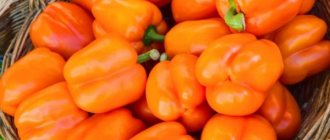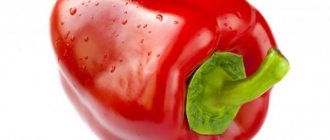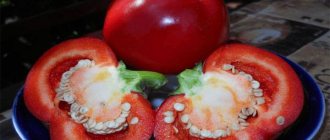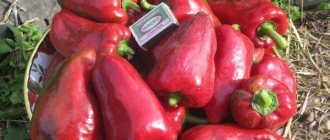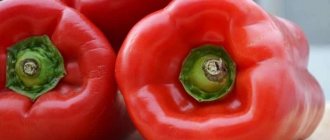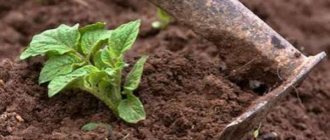Description and characteristics of the variety
Bell pepper Poljot is a non-hybrid variety of sweet pepper. It is produced in Russia.
It is recommended to grow it in open ground in the North Caucasus and Central Black Earth regions, and in other areas it is recommended to plant it in film greenhouses and shelters. Since the bush is short - 45-50 cm - it can be sown as a compactor for tall crops.
Ripening time depends on growing conditions. In warm and comfortable conditions, the fruits ripen 80-100 days after full germination. If conditions are stressful and cool, ripening takes 120-130 days.
In greenhouses, fruits ripen earlier than in open ground.
The peppers are cone-shaped, slightly ribbed, and dark red in color when fully ripe. Weight - from 100 g, but there are specimens up to 250-300 g, if the bushes are provided with enhanced feeding. Wall thickness – 6-8 mm. The length of the fruit is about 15 cm, and the diameter is 6-10 cm. There are 2-3 seed chambers inside.
The taste is sweet and pleasant. Universal use - for fresh consumption, cooking, including stuffing, canning and freezing.
The pulp contains:
- dry matter – 7.2-8.3%;
- sugar – 2.4-4.2%
- ascorbic acid – 55 mg per 100 g.
Farmer reviews
Most gardeners are satisfied with the harvest and taste of Polet pepper , but some were disappointed, as they expected much more from the pepper.
Pavel, Orel : “I planted the Polet variety for the first time, I liked the result. The peppers are beautiful and smooth. The maximum weight of one fruit reached 160 g. I prepared a salad from the vegetables and marinated them for the winter.”
Maria, Saratov : “I love sweet peppers, every year I experiment and plant a new variety. Polet is an ideal greenhouse vegetable. The fruits are smooth and very appetizing. I planted seedlings and fertilized them with liquid organic matter.”
Olga, Sochi : “Pepper Flight disappointed me, because at the beginning of July I noticed Colorado beetles on the leaves. I fought with professional medications, but the beetle still ate some of the bushes.”
Landing
Seeds are planted in common boxes or individual pots 60-70 days before transferring to a permanent place. Before planting, they are kept for half an hour in a one percent solution of potassium permanganate to protect against diseases. Then they are treated with a special stimulant, and then prepared for germination. To do this, place the seeds in warm water about +50 degrees for several hours. They will swell and rise faster.
The soil is prepared from garden soil, peat and sand or sawdust. You can add a little humus and wood ash. If the acidity exceeds pH 6.4, add enough ash to neutralize the environment. Then the prepared soil is calcined in an oven or poured with a hot solution of potassium permanganate.
Furrows are made at a distance of 2-3 cm from each other with a depth of 0.5-1 cm. Seeds are sown in them, covered with soil, moistened and placed for germination in a room with a temperature of +23-24 degrees. It's better to cover with film. After germination, transfer to the windowsill, provide lighting for 12-16 hours a day and a temperature of +18-22.
From common containers, seedlings are planted in separate pots at the 2-3 leaf stage. Harden off before planting in the ground.
The plot is transplanted according to a 40 by 40 cm pattern. The transplant is carried out together with a lump of earth so as not to damage the roots.
Sweet peppers are placed away from hot ones.
Growing the variety "Polet"
Growing standard-type peppers is easy to care for. Basic care tips:
- Seeds should be sown no later than February for greenhouse cultivation and no later than March for further cultivation in open soil. Seeds begin to germinate 5-6 days after sowing. The temperature in the greenhouse where the seedlings grow should be 20 degrees. Irrigation is carried out with warm water.
- When replanting, feed the plants with complex potassium-phosphorus fertilizers. You can also use spraying with growth stimulants, then the plant will quickly gain green mass and begin to form fruits.
- When planting, adhere to the planting pattern: 50 cm between rows, and 35-40 cm between plants. Provide frequent but moderate watering.
- Harvesting, subject to proper care and timing of seed planting, begins at the end of July.
You may be interested in: Favorable days for picking pepper in 2021 according to the lunar calendar Favorable days for planting pepper for seedlings in 2021: terms and rules for sowing at home Favorable days for sowing sweet and bitter pepper for seedlings in 2021
Growing and care
The bushes are watered twice a week or more often, as needed. Warm, settled water is carefully applied to the root. When the bushes take root in a permanent place, loosen the soil. It is treated after each watering to a depth of 7-8 cm.
No tying or shaping required.
Fertilizers are applied three times per season:
- before the bushes bloom (possible at the seedling stage);
- during flowering;
- during the ripening period.
Until the pepper has bloomed, you can use organic matter - a solution of mullein, fermented herbal infusion. After flowering, preference is given to potassium-phosphorus mineral complexes.
Pests and diseases
Flight has good immunity to many pepper diseases. However, if you do not take care of the beds fully, then the peppers are quickly affected by late blight, white rot or blossom end rot. All this can happen from constant waterlogging of the soil.
It is impossible to defeat these diseases - you will still lose. Therefore, it is necessary to carry out preventive measures aimed at ventilating the soil.
Of the pests, Flying is often attacked by the cutworm. The parasite digs into the stems and chews them. Outwardly, it is almost impossible to distinguish diseased bushes from healthy ones. This caterpillar is very voracious, and if it has laid a lot of larvae, then the insects can completely eat all the leaves and fruits.
Signs of plant damage by pests:
- leaves change color;
- plants wither;
- peppers stop growing;
- not only leaves, but also flowers and fruit ovaries can fade;
- Many parasites hide in the soil, so recognizing their presence can be difficult.
Irrigation of bushes with biological preparations is considered the best protection against insect pests. Very effective in this regard are such products as “Fitoverm”, “Lipidocid”, “Bitoxibacillin”, “Nemabakt” and “Aktofit”. You need to spray the bushes at least three times a season. Among folk remedies, those that are “at hand”, so to speak, ash is better suited. Ash should be sprayed onto wet leaves. It is also advisable to use high-quality and balanced fertilizers of organic and mineral types during autumn and spring digging of the site.
Agricultural technology
Growing Polet peppers is no more difficult than other varieties. work begins in February, with sowing seeds for seedlings. By the time seedlings are planted in open ground in May, they should be about 100 days old.
Pepper seedlings are very thin and tender and do not tolerate picking, so it is best to sow the seeds in small peat pots and then move the seedlings into the ground together with the substrate. If there are no pots, you can get by with a regular container and plant the seedlings in the ground immediately after removing them from it.
The bottoms of pots or cups are pierced so that moisture does not stagnate in them. If the seeds are sown in a container, a drainage layer is placed at the bottom for excess water.
The mixture for planting seeds is prepared from humus, soil and sand, taken in a ratio of 2x1x1, then it is enriched with wood ash at the rate of 1 tablespoon of ash per kilogram of substrate.
The seeds are prepared for sowing in advance; they are kept in warm water for 4-5 hours, after which they are transferred to a damp cloth, where they remain for 2-3 days at a temperature not lower than +20 degrees. With this preparation, seedlings appear a day after sowing.
Seeds can be buried in a moist substrate, but they can be scattered over its moistened surface and sprinkled with dry soil on top. This way the seeds will breathe freely and the moisture will not evaporate too quickly.
Containers with crops are placed in a warm place, the air temperature should be between 25-29 degrees during the day, and not lower than 16 degrees at night.
Water the seedlings when the soil dries out; there is no need to overwater them, everything is good in moderation, otherwise diseases cannot be avoided. It is better to heat water for irrigation to 30 degrees.
On warm spring days, containers with seedlings can be taken outside for hardening, first for 1-2 hours, then the time is extended to 6-7 hours. The main thing is that it is warm and calm outside.
Planting in open ground occurs at the moment when the threat of frost has passed, and at night the temperature will not drop below +17-18 degrees.
Pepper loves light and warmth; it needs to be planted in a well-lit place. Preferably after onions, cucumbers, pumpkins, zucchini, cabbage and carrots. The worst predecessors are nightshade and pepper.
Seedlings are planted in the ground at the same depth at which they grew before - in a pot or container.
The soil is prepared in advance, during autumn digging. 50 grams of potassium-phosphorus fertilizers and about 5 kg of humus are added to 1 square. In spring, ammonium nitrate is used as a fertilizer. It is also necessary to take care of disinfecting the soil; water it with a solution of copper sulfate - dissolve a tablespoon of powder in 1 bucket of water.
Read also: Raspberry variety Krepysh - description, planting, care, reviews
Pepper Polet: reviews, photos
The Polet variety of pepper is ideal for growing in private plots and spacious farm fields. It annually shows high and stable yields and is easy to plant and care for.
The taste and commercial qualities of sweet pepper are excellent, which makes it possible to use it in the preparation of a wide variety of dishes. Let's take a closer look at what Polet pepper is and how to grow it correctly.
What type of pepper is this?
The variety appeared thanks to the work of Moldovan breeders, and only a few years later came to Russia. The vegetable is recommended for cultivation in the Central Black Earth and North Caucasus regions . Depending on climatic conditions, peppers are grown in greenhouses or in the open air.
Characteristics and description of the variety
Poljot is a mid-season variety, the ripening period ranges from 110 to 140 days . The bushes are small, reaching a height of 50-60 cm. There are few leaves, they are rough to the touch and have a dark green color. The plant rarely gets sick, especially if it is planted in greenhouses or greenhouses.
Fruit characteristics and yield
Peppers are medium in size, cone-shaped . At the stage of technical ripeness they acquire a green color, then turn yellow or red. The weight of one fruit varies from 100 to 150 g.
The length is about 15 cm, the wall thickness is 8 mm, so the variety is perfectly stored and can be transported over long distances. Productivity - 8 kg per 1 sq. m. The surface is glossy, smooth. The taste is sweet and juicy, the pulp contains a large amount of vitamins and mineral components.
Interesting! Bell pepper is a dietary product, since 100 g of the vegetable contains only 27 kcal. The vegetable is enriched with dietary fiber, fiber, ascorbic and folic acid, which makes dishes with the addition of bell pepper extremely healthy.
Preparation for cultivation
Preparations for cultivation begin in March . The first step is to choose a place to plant the vegetable. Pepper thrives in loose and fertile soils with low acidity levels.
To prepare the beds, remove all debris, weeds and remnants of last year's plants. The soil is carefully dug up and peat, humus or leaves are added to the soil. These elements warm the earth and have a positive effect on plant growth. Large and hard clods of earth must be broken up with a shovel or rake, after which the soil is leveled.
Important! If the row spacing in the beds is not visible, it is recommended to trample them down and cover them with a layer of straw or foliage. To ensure that the edges of the beds remain clear, a rope is stretched across the border and secured with wooden pegs. This technique will give the beds a well-groomed and healthy look.
An important stage is seed preparation . First, they are checked for germination. This is done using a saline solution, where the seeds are dropped and stirred clockwise. Those specimens that sank to the bottom are suitable for planting, as they turned out to be the heaviest.
The seeds are soaked in a solution of Bordeaux mixture or Formalin for 3-4 hours, then left to dry on a clean napkin. The final stage of preparation is hardening. The seed material is placed in the freezer for a day, after which the seedlings are planted.
Planting seedlings
Polet pepper seedlings are prepared 20-30 days before planting in the garden . For this, prepare a special container: peat pots, thick cardboard boxes, clay pots. The container is first washed with water and soda. Prepare the soil for seedlings yourself or buy a ready-made mixture in the store.
Some gardeners go the other way , mixing soil from the garden and purchased soil. First, the soil for seedlings is hardened for 3 hours in the oven at a temperature of +60°C. High temperature destroys pathogenic microflora on the surface of the seeds.
About other varieties of pepper:
The distance between seedlings should be at least 10 cm . As soon as the first leaves hatch, the sprouts are watered. For moisturizing, use only water at room temperature; cold water from the tap is harmful for young and weak bushes.
For convenience, use a pipette so that water flows directly under the root . After 2 weeks, the seedlings are fed with liquid organic fertilizers, such as chicken droppings or a solution of wood ash. Fertilizers improve the immunity of peppers and protect against diseases. To accelerate the growth of seedlings, the stimulator “Kornevin” is added; it strengthens the root system and stem.
Important! If the seedlings are planted in small cups, then after 10-15 days they are planted in larger containers. Otherwise, the roots will not have enough space to develop. When picking, water the soil generously, carefully remove the sprout with a lump of earth and place it in new soil. Experienced gardeners advise beginners to be extremely careful, as fragile stems can break.
Planting and care
Seedlings are planted on a cloudy, windless day . The bushes are carefully removed from the containers and placed in pre-prepared holes in the beds. The distance between the grooves should be at least 60-70 cm.
The seedlings are patted down with earth and watered abundantly. When planting the Polet variety in open ground, it is recommended to cover the sprouts with polyethylene so that the pepper is not damaged by wind, rain and fog. After 7-10 days, the film is removed.
Further care of the plant is as follows:
- Regular watering . The beds are moistened every 5 days; 1-1.5 liters of water are consumed per bush. Water carefully, directing the stream directly to the root. When using a watering can, be sure to use a nozzle; when watering with a hose, put on a special diffuser. The water temperature must be at least +20°C. If the summer is hot and rainy, then the amount of water is reduced.
- Weeding . In the beds you can often see bindweed, dandelions, wood lice and other plants. Unwanted vegetation worsens the microflora of beds and leads to the emergence of insect pests. Remove weeds before watering.
- Loosening the beds . Once a week, gardeners advise loosening the beds so that the soil is saturated with oxygen. Loosen the soil to a depth of 10 cm, away from the roots. Usually the procedure is combined with weeding.
- Fertilizer . Throughout the entire growing period, plants are fertilized with organic and mineral fertilizers. They improve the taste of fruits, protect against diseases, and increase immunity. Urea, superphosphate, Bordeaux mixture, ash, burdock infusion, and ammonium nitrate are recognized as excellent remedies. Fertilize peppers every 10-15 days. Gardeners recommend fertilizing in the morning or evening to avoid burns.
Features of cultivation and possible difficulties
Despite the fact that the Poljot variety is unpretentious in care, sometimes gardeners have problems with growing it. To avoid them, we advise you to adhere to the following recommendations :
- when planting in a greenhouse, thoroughly wipe all surfaces with a disinfectant;
- water the bushes only in the early morning;
- for irrigation, use settled water;
- alternate organic and mineral fertilizers;
- follow the rules of crop rotation;
- use foliar sprays as protection against insects;
- Regularly ventilate greenhouses or greenhouses.
If the leaves become dry and yellow , the plant is probably lacking minerals: nitrogen, phosphorus, calcium. To prevent problems, it is advised to carefully monitor the amount of fertilizer applied and read the dosage recommendations.
Sometimes the opposite situation happens - there are too many minerals , which is why the fruits stop growing and the foliage grows rapidly. Sprinkling with dry wood ash and abundant watering will help correct the situation.
Typical diseases and pests
Among the pests, thrips - black bugs with a striped abdomen - attack the beds . As a rule, they appear during the flowering period, when the fruits are just beginning to ripen. Thrips suck the juice and nectar from the plant, which is why the peppers begin to slowly die.
Thrips are excellent camouflages , so it is not easy to see them with the naked eye. As a preventative measure, gardeners regularly inspect the bushes and spray them with HOM.
Colorado beetles also have a negative effect on peppers. The well-known striped insects and their larvae are capable of destroying entire crops. “Typhoon” or “Tornado” products help fight pests.
Important! The causes of many pests lie in improper care, contaminated soil or high humidity. Therefore, it is important to follow the rules of disinfection and proper care of the plant.
Among the diseases noted is tobacco mosaic . The disease appears in the form of a yellow pattern on the leaves, which becomes larger over time. You can become infected with mosaic from soil, weeds, and water.
As a preventive measure, it is recommended to water the beds with Bordeaux mixture or a solution of onion peels. In addition to the mosaic, the pepper is “attacked” by powdery mildew in the form of a white coating.
Treatment of bushes with whey is recognized as an excellent remedy for the disease.
Advantages and disadvantages of the variety
The Polet pepper variety has many advantages . It is tasty and beautiful, looks appetizing on any table or as a winter preparation. The soft and sweet pulp is full of useful elements that are necessary to maintain health and strong immunity.
The commercial qualities of the vegetable are excellent ; thanks to the thick walls, the fruits are stored for a long time without losing their qualities. The variety does not require special knowledge and skills to care for, so even a beginner can get a good harvest.
Among the disadvantages, they note the fact that the Polet variety shows high yield only in greenhouse conditions; in open ground, the number of tasty fruits is much less.
Interesting! Sweet peppers make great stuffed peppers. Meat, spices, herbs, vegetables, seafood, and even pineapples are used as filling. Such dishes are simple to prepare, and the pepper itself serves as an excellent base.
Farmer reviews
Most gardeners are satisfied with the harvest and taste of Polet pepper , but some were disappointed, as they expected much more from the pepper.
Pavel, Orel : “I planted the Polet variety for the first time, I liked the result. The peppers are beautiful and smooth. The maximum weight of one fruit reached 160 g. I prepared a salad from the vegetables and marinated them for the winter.”
Maria, Saratov : “I love sweet peppers, every year I experiment and plant a new variety. Polet is an ideal greenhouse vegetable. The fruits are smooth and very appetizing. I planted seedlings and fertilized them with liquid organic matter.”
Olga, Sochi : “Pepper Flight disappointed me, because at the beginning of July I noticed Colorado beetles on the leaves. I fought with professional medications, but the beetle still ate some of the bushes.”
Conclusion
To grow Polet peppers correctly, it is advised to carefully monitor the amount of fertilizing and fertilizer applied. It is better to alternate minerals and organic matter to ensure a balanced and healthy diet. Pepper loves ash, manure, and nitrogen-containing elements.
Harvest as they ripen, when the vegetables become elastic and hard. Store the fruits in a dark place, covering the top with newspaper or thin polyethylene. Part of the harvest is consumed fresh, part is processed and prepared for the winter.
Characteristics and care of pepper “Polyot”
The Polet pepper variety is better known to professional farmers who grow peppers for sale. Its characteristics, in particular excellent external qualities and good shelf life, are highly valued on the market.
That is why this type of pepper is extremely popular.
general description
The “Flight” variety was developed by agronomists of the Moldavian Research Center for Seed Breeding and Agricultural Technology Panchev Yu.I. and Ilyenko T.S. At home, pepper was received well.
The flight quickly spread throughout the country and became widely used not only in industrial farms, but also in private lands.
Moldova and Ukraine are two countries in which Polet quickly took root, and became almost one of the most popular varieties of pepper.
Poljot came to Russia several years later, only in the late 90s. The variety was included in the state register of agricultural crops in 1997. The variety is best suited for cultivation in the Central Black Earth and North Caucasus regions. It is also possible to grow Polet in other regions, but it is recommended to do this in greenhouse conditions or greenhouses.
Until now, few summer residents in Russia know about this variety, even fewer who grew it. However, Polet is a very worthy variety among representatives of this culture. It has many features that pepper connoisseurs put first.
Source: https://vegetory.ru/sad-i-ogorod/perecz-polet-otzyvy-foto


